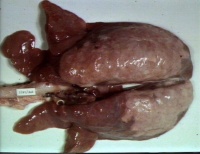Enzootic Pneumonia - Pigs
Also Known As: EP — Mycoplasma hyopneumoniae infection
Caused By: Mycoplasma hyopneumoniae
Introduction
Enzootic pneumonia in pigs is a chronic, multimodal respiratory disease of pigs caused by Mycoplasma hyopneumoniae and in many other cases, also other pathogens such as Pasteurella multocida, Streptococcus suis, Haemophilus parasuis and Actinobacillus pleuropneumoniae.
Enzootic pneumonia can also be a component of Porcine Respiratory Disease Complex, when combined with Porcine Circovirus 2 and/or Swine Influenza.
Enzootic pneumonia is not zoonotic.
Distribution
Worldwide. M. hyopneumoniae is ubiquitous in all significant pig producing regions globally.
Transmission is mainly from infected animals, which can be horizontal between penmates or vertical from sows. [1] It can also be airborne. [2]
Due to the fastidious nature of the organism, transmission between herds across any great distance is unusual.
Signalment
Only pigs are affected.
Although all ages can be affected, due to the slow growing nature of M. hyopneumoniae, clinical disease is most commonly seen at finishing/fattening, at >8 weeks of age.
Disease is more common on units that have an on-site finishing system due to the timing of disease and shedding of the bacterium.
Clinical Signs
The respiratory disease cases tachypnoea, hyperpnoea, dyspnoea and coughing. Before manifestation of respiratory disease, low productivity and reduced growth rates may be seen in young animals.
Although signs are unusual in pigs <6-8 weeks of age, concurrent infection with PRRS can cause earlier clinical disease.
Diagnosis
EP is often suspected if coughing pigs are present at the appropriate age.
Culture and isolation are the gold standard but are difficult. See Mycoplasma hyopneumoniae for more details.
PCR can confirm the presence of the bacterium in the nasal cavity, [3] or from lung tissue or bronchial washings. The latter two are the most reliable materials. Nested PCR requires very few organisms to be present for a positive result.
Indirect ELISA is the most effective and commonly used test for detecting antibodies to M. hyopneumoniae. Sensitivity is low but specificity high. Colostrum can also be tested for antibodies which may provide a premonitory tool.
Fluorescent antibody tests (FAT) or Immunohistochemistry (IHC) can also be performed using fixed or frozen tissue samples. It is essential that ciliated epithelial cells are included for this type of analysis.
At post-mortem, purple-grey consolidated areas are evident, particularly in the ventral portions of the cranial and middle lobes and the cranioventral portions of the caudal lobes. Lesions become more widespread as disease progresses. Lymph node enlargement and catarrhal exudate often accompany these pathological changes.
Microscopically, non-specific neutrophilic inflammation is present with progressive leucocyte infiltration of tissues and airways. Severity of microscopic lesions increases with secondary pathogens. None of these pathological changes are specific to EP.
A variety of tests are often employed for diagnosis of EP in pigs and sensitivity and specificity should be considered for each modality combined with consideration of whether detection is for diagnosis or herd screening.
Treatment
Vaccination is the most effective and common method of control of clinical disease, reducing severity and transmission of EP.
Antibiotics, typically quinolones, can help to control disease but do not usually eliminate the organism or help lesions to recover. Other antibiotics appear to be bacteriostatic rather than bacteriocidal. Resistance to tetracyclines has been reported. [4]
Eradication strategies have been employed using partial depopulation and preventing entry of animals under 10 months of age. These have been successful in various European countries. [1] Even after successful eradication though, reinfection is still common.
Control
Eradication strategies as discussed above are valuable in prevention and acquisition of a developing outbreak.
The other key tool in control is vaccination. Adjuvanted membrane vaccines and whole cell vaccines are available.
| Enzootic Pneumonia - Pigs Learning Resources | |
|---|---|
 Test your knowledge using flashcard type questions |
Enzootic Pneumonia in Pigs Flashcards |
References
- ↑ 1.0 1.1 Rautiainen, E., Oravainen, J., Virolainen, J. V., Tuovinen, V (2001) Regional eradication of Mycoplasma hyopneumoniae from pig herds and documentation of freedom of the disease. Acta Veterinaria Scandinavica, 42(3):355-364; 29
- ↑ Stärk, K. D. C., Nicolet, J., Frey, J (1998) Detection of Mycoplasma hyopneumoniae by air sampling with a nested PCR assay. Applied & Environmental Microbiology, 64(2):543-548; 27
- ↑ Kurth, K. T., Hsu, T., Snook, E. R., Thacker, E. L., Thacker, B. J., Minion, F. C (2002) Use of a Mycoplasma hyopneumoniae nested polymerase chain reaction test to determine the optimal sampling sites in swine. J Vet Diagnostic Investigation, 14(6):463-469; 25
- ↑ Maes, D., Verdonck, M., Deluyker, H., De Kruif, A (1996) Enzootic pneumonia in pigs. Vet Quart, 18:104-9
Animal Health & Production Compendium, Enzootic Pneumonia of pigs datasheet, accessed 25/06/2011 @ http://www.cabi.org/ahpc/
Animal Health & Production Compendium, Mycoplasma hyopneumoniae datasheet, accessed 25/06/2011 @ http://www.cabi.org/ahpc/
| This article has been peer reviewed but is awaiting expert review. If you would like to help with this, please see more information about expert reviewing. |
